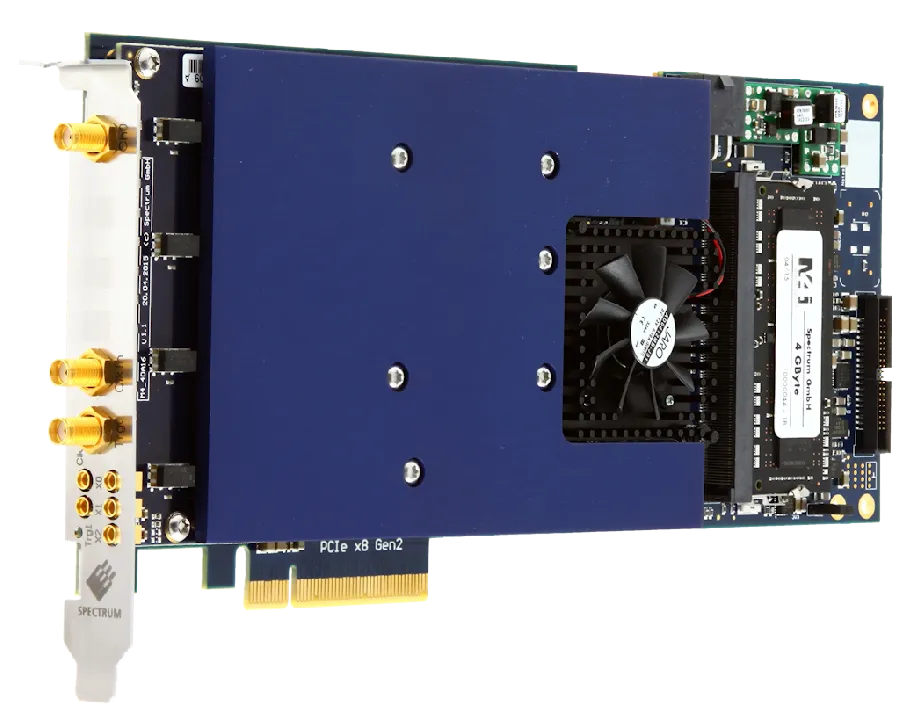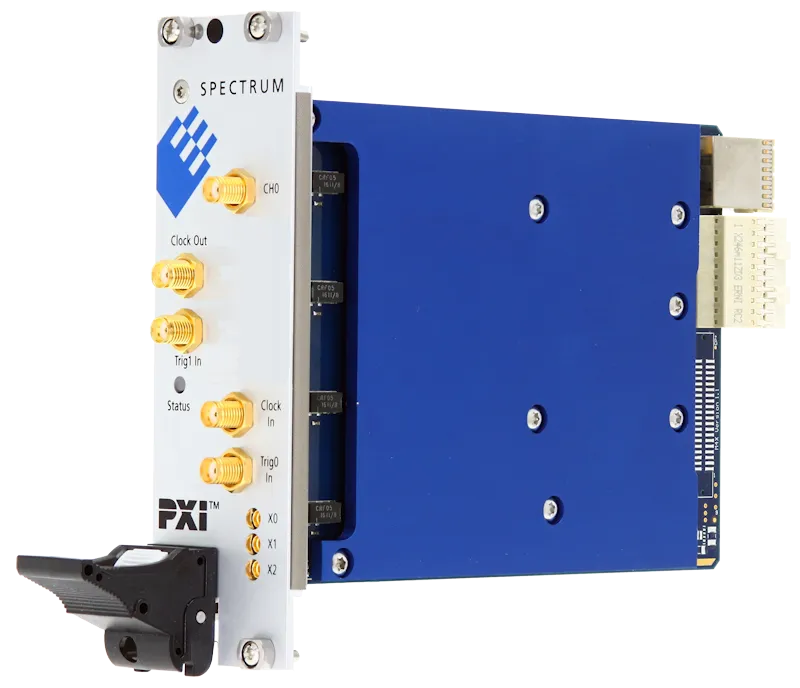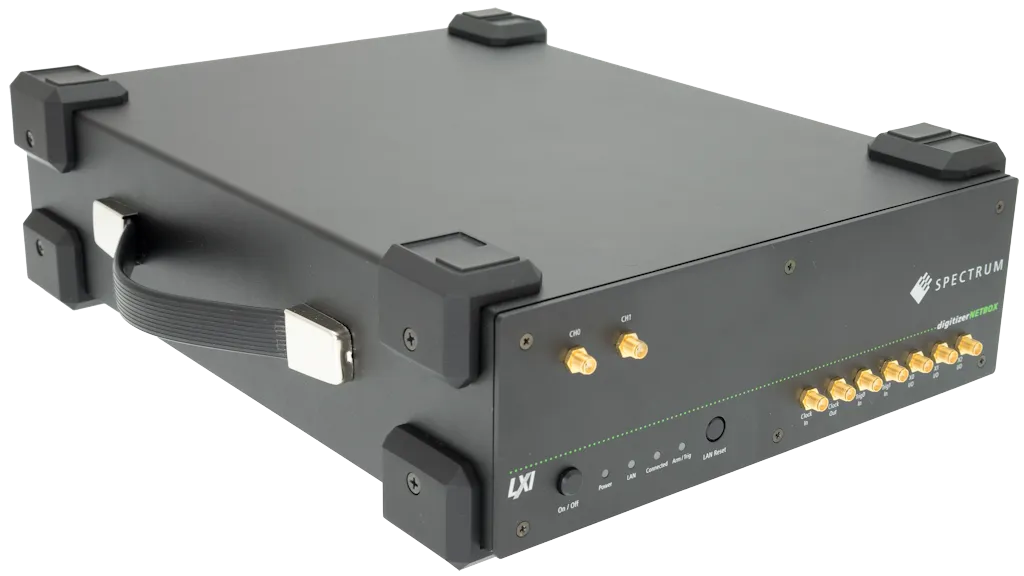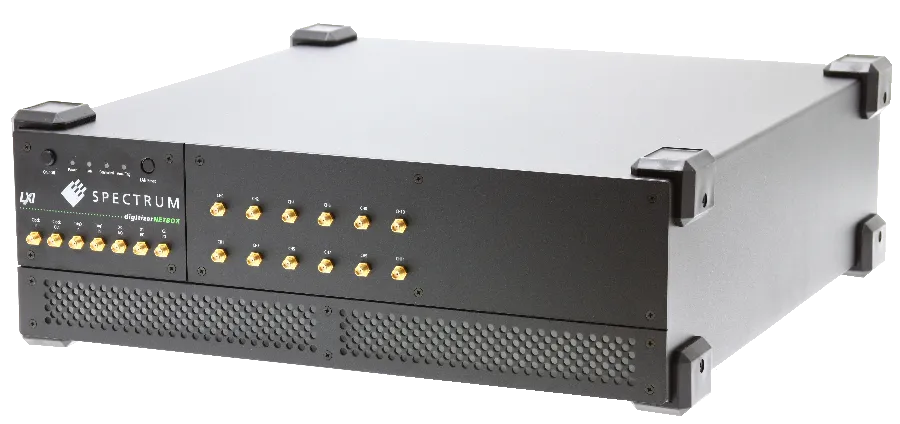Digitizer
Digitizers are the standard tool to get analog data into a PC for further processing.
A/D products and Digitizers
Digitizers are the standard tool to get analog data into a PC for further processing. They differ in the platform, sampling rate, resolution, number of channels, memory and different modes available. There are different names for the same type of product: A/D cards, Digitizers, Transient Recorders, Data Acquisition Cards, Scope Cards, PC Scope, Signal Capture Card and more.
The A/D product can either come in the form of a plug-in card, as a remote/Ethernet instrument or as a complete system containing the A/D acquisition part, an integrated PC and the operating software SBench 6.
SBench 6Digitizer families Digitizer
22xx
Family
A/D family
Sample rate
1.25 GS/s - 5 GS/s
Resolution
8 Bit
44xx
Family
A/D family
Sample rate
130 MS/s - 500 MS/s
Resolution
14 Bit 16 Bit
59xx
Family
A/D family
Sample rate
5 MS/s - 125 MS/s
Resolution
16 Bit
33xx
Family
A/D family
Sample rate
3.20 GS/s - 10 GS/s
Resolution
12 Bit
Common Applications for Digitizers
The Spectrum Digitizer is a high precision tool that can be used in a huge variety of applications. Some of them are:
Radar and Lidar data acquisition
ATE
Research and Development
OEM Products
Mixed Mode DAQ
more Applications
Mixed Mode DAQ
Most of Spectrum digitizers and A/D cards allow to be used as a mixed mode DAQ (data acquisition) device by combining analog and digital channels in one system. The combination can either be done by adding digital input options into the card making a single card mixed mode DAQ out of it or by combining tow or more cards using the internal Star-Hub. Combining digitizers with digital waveform acquisition cards can generate a mixed mode DAQ system with a wiede variety of channel combinations.
Compact Knowledge Base
A/D, Digitizers, Transient Recorders Basics
Digitizer
A digitizer is an electronic acquisition device that acquires analog waveforms, processes them through analog-to-digital converters (ADC's) and sends the digitized sample to a buffer, which allows them to be saved before being processed by a computer. Waveform digitizers are plug-in cards for PCs or industrial PCs that are used to measure continuous voltage signals as well as fast signal changes like voltage transients. Therefore they're also called transient recorder.
The right hand picture shows digitizers for different platforms.
PC Transient Recorder
Transient recorders acquire transient (single, fast) events. They're designed for single-shot applications and normally have a long data acquisition memory and a fast sampling rate. Combining a digitizer with a PC and some software like SBench 6 can be used as a PC transient recorder with more features and options than a classic stand-alone transient recorder. The picture on the right shows the combination of a digitizer and SBench 6 software used as a PC transient recorder.
Detailed Information
- Articles on Digitizer Fundamentals
Selecting a Digitizer
Selecting a digitizer requires that you match the application waveforms to the key digitizer specifications. This section provides some common rules of thumb to aid in the selection of a digitizer.
Bandwidth
The required bandwidth of a digitizer depends on the nature of the waveforms you are measuring. For sine waves a bandwidth of greater than twice the maximum frequency is generally adequate. If the waveform is pulse-like with fast transitions it is preferable to use a bandwidth that is five times the frequency of the pulse waveform in order to capture up to the fifth harmonic. In order to approximate a square wave the bandwidth should allow transmission of up to the fifth harmonic.
Samplerate
The sampling theorem states that to avoid aliasing, the sample rate of a digitizer needs to be at least twice the highest frequency component in the signal being acquired. Sampling at just twice the highest frequency component is not enough to accurately reproduce fast edges in time-domain signals. Accurate digitizing of a signal requires the digitizers sample rate should be at least three to four times the required bandwidth.
Resolution and Dynamic Range
Resolution determines the dynamic range of the digitizer. The dynamic range is the ratio of the highest to the lowest signal level a digitizer can handle. Applications that involve dynamic signals (signals with both large and small voltage components) need a high-resolution instrument. As a first order estimate of the required dynamic range divide the highest signal level by the smallest signal level that is expected. As an example, consider a full scale range of 1 Volt and the desired minimum detectable signal level of 100uV. The ratio is 10,000:1 or 80 dB. With 6 dB per bit this requires 13.3 bits of resolution in an ideal case with no additive noise, so a 14 bit digitizer would be required.
Acquisition Memory Length
Determines the longest record length the digitizer can accommodate in a single acquisition. It also affects the sample rate on any given record duration. Record length is equal to the sample period times the acquisition memory length. For a given digitizer record length the greater the memory length the higher the sample rate that can be used without overflowing the memory. Using a digitizer as PC transient recorder the acquisition memory length can become the most important specification.
Triggering
Triggers synchronize data acquisition with external events. Effective use of a digitizer requires great flexibility in device triggering. Simple edge triggers based on the slope and signal level are pretty standard on most digitizers. Many offer window triggering as well. Trigger sources include the acquisition channels and multiple external trigger inputs. For maximum trigger flexibility these inputs along with a rearm capability can be combined logically to produce advanced trigger states.
Number of channels and Synchronization
Each modular digitizer has a specific number of channels per card. Using multiple cards can increase the total number of channels. In order to maintain synchronization, multiple cards need to be synchronized so that they share common triggers and a common clock.
Acquisition modes
Digitizers generally offer a number of different acquisition modes. The Spectrum digitizers offers ring buffer mode (similar to an oscilloscope operation), FIFO or streaming mode, Multiple Recording (segment mode), Gated Sampling, and a multiple time base (ABA mode) which combines slow continuous recording with a fast acquisition on trigger events. These multiple acquisition modes feature a fast re-arm time.
Digital Data Transfer
One of the key advantages of digitizers is the ability to rapidly stream data to a computer for further analysis and archiving. The Spectrum digitizers, in FIFO mode (streaming mode), are designed for continuous data transfer between the digitizer buffer memory and PC memory. The available streaming speed depends on the used digitizer platform (PCI Express, PCI, PXI, cPCI, LXI)
Form factor
Modern digitizers come in a variety of different form factors and standards. Today's most popular are PCIe, typically used when size is critical and the digitizer needs to go inside the PC, and PXI. When building large automated testing systems, with a number of different test instruments, choosing a common form factor generally makes the integration task much easier.
LXI/Ethernet instruments allow the connection with Laptop and desktop PC or the location anywhere in the company LAN. They can run as external digitizers or as PC transient recorders.



